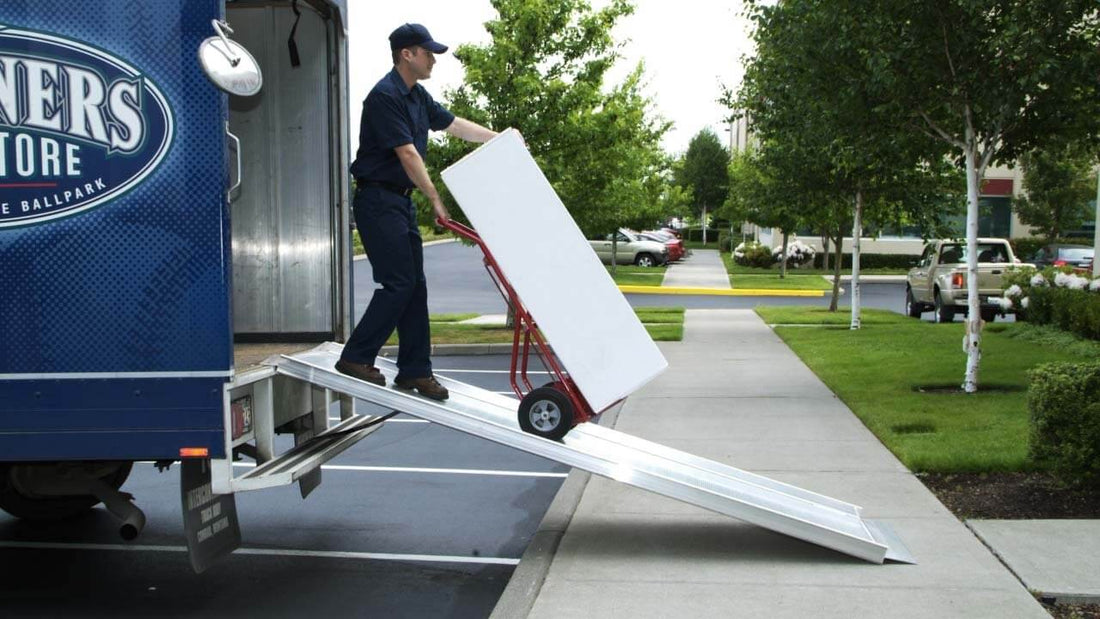Portable loading ramps are engineered for the loading and unloading of cargo to and from loading docks, trucks, trailers, rail cars, platforms, and many other industrial stages.
They are typically constructed from steel, have wheels for setup and mobility, have a mechanism to lower and raise the loading surface, and can hold a weight capacity of between 15,000 and 30,000 pounds. Like a typical loading dock, a portable loading ramp can be set up permanently using a stationary support stand for trucks to back into it. Some portable loading ramps have handrails allowing them to be used as walking ramps between platforms and trailers.
Given their usage versatility, there are several important factors to consider before purchasing a portable loading dock. Keep reading this buying guide to portable loading ramps to help you make the decision.
Calculate the Width and Height of Your Largest Cargo
To ensure your drivers have side and height clearance, always measure an additional 15 inches wider than the widest and tallest piece of cargo or equipment. If you plan on using the portable loading ramp on a rail car, make sure to measure the car door opening so the ramp will fit and is wide enough to prevent the equipment from striking the curbs.
Decide if you Need a Level-Off Feature
When loading a trailer from the ground, ramps with a level-off feature at the top are the best option since it allows the forklift to stabilize before entering the truck cargo hold. Without the level-off feature, your load will enter at an angle that increases the difficulty of placement.
Determine the Minimum Weight Capacity
One of the most important considerations in this buying guide to portable loading ramps is to determine the lowest weight capacity. This can be a challenge when you have loads with varying weights across multiple shifts, but it is a critical aspect of ensuring the ramp can meet your needs. The lower end of the portable ramp’s weight capacity should begin at three times the heaviness of your heaviest equipment with the expected heaviest cargo weight. When you find a ramp that can meet this weight capacity the anything above will suit your needs.
Establish Which Structural Features are Required
It is critical to establish which portable loading dock features are best for your needs. Portable ramps can be customized with a variety of features including self-supported capabilities, a hand crank, a tow bar, handrails, and surrogated grates, to name a few. By understanding the potential usage of these ramps, you can narrow down the features most important to you.
Estimate the Anticipated Length
Loading docks are available in two options: straight and level-off. The strait portable loading dock is just an incline so the length will be from the ground to the edge of the truck. However, the level-off loading ramp adds length to the end so forklifts can more easily maneuver. If you are tight on space, then the level-off may not be the best option.
Recognize if you Need a Mini or Custom Ramp
Mini portable ramps are a lower cost and smaller version of the traditional ramp. The mini ramp usually does not have an undercarriage but could come with an adjustable leg stand. These ramps were designed for drive-in access to shorter dock heights or to provide access to a truck from a lower dock height. Custom ramps can be created for various special needs. For instance, if you have unique loading dock requirements or have special weight capacities, custom ramps are an excellent option to meet your cargo needs.
Understand if you Require a Portable or Stationary Ramp
To create access from the dock to the ground, a stationary ramp is an excellent choice since it will remain in place but can be moved by a forklift. However, if you need to load or unload a truck without a dock, a portable loading ramp is the best option since it will be easier to position or move between trucks. Most portable ramps have hydraulic lifts to adjust to different heights.
There are many factors to consider before purchasing a portable loading dock ramp. You want to ensure all calculations are accurate, so you purchase the best option to fit your needs. You also want to determine if special features, like a level-off, are required and if you require a mini or customized ramp. When making these determinations, discuss the requirements with your employees, especially the forklift drivers, who will be using the ramps the most. Once you have all these variables determined, you can find the most reputable brand and ramps available to make the purchase!

